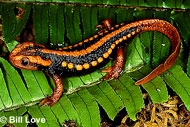Description:
This species has long been imported as T. verrucosum, a more variable but often paler species that is now known as the Himalayan knobby newt. Except for the fact that the true T. verrucosum seems a bit more aquatic, the care regimen for the two species is identical. The majority of these newts in the pet trade are collected from the wild as adults. Though their age when collected is unknown, when well cared for in captivity they have been known to live for more than 15 years. The likelihood is that this newt species lives for more than two decades. Despite having a ground color of brown to nearly black, the extensive bright orange highlights make this a colorful newt. Although it may vary in intensity, the brightest orange occurs along a broad vertebral stripe and the row of orange tuberculate (glandular) spots along each side. The belly, lower sides, throat, tail, limbs and head (except for a dark eyestripe) are clad in a somewhat paler orange hue. The glandular dorsolateral tubercles and other skin glands produce a virulent toxin. Care should be taken to wash your hands carefully both before and after handling this (or any) newt. This newt prefers seasonally cool temperatures. Winter temperatures of 58 to 62 degrees Fahrenheit and summer temperatures of 72 to 78 degrees are ideal. A natural seasonal photoperiod should also be provided. By following this temperature and photoperiod regimen Mandarin newts may cycle for breeding. Terrestrial throughout most of the year, the Mandarin newt often becomes more aquatic during the spring and summer breeding season. Sufficient water and land should be provided to captives to allow the newts to make their choice. Although courtship may begin on land, the newt pair will usually soon enter the water for completion of the breeding sequence. Twenty, to more than 100 eggs, are placed by the female on rocks (seemingly the preferred locale) and plants. Because it is a large newt, the Mandarin newt should be housed in a 15 gallon or larger terrarium. It will survive well singly or in small groups. They will thrive in either a woodland terrarium with a small water receptacle or a semi-aquatic terrarium. In either case the water must be kept fresh and clean. In the woodland terrarium clean water may be provided in a rigid plastic food storage dish buried to its rim in the substrate. One having a footprint of 9 by 7 inches and a depth of 4 inches is ideal. Whether the water is contained in a receptacle or the terrarium is of a specifically designed semi-aquatic format, easy egress (such as a gently inclined ramp) from the water must be provided for the newts. The terrarium substrate may consist of slightly moistened sphagnum, damp (not wet) compacted soil (potting soil that contains neither vermiculite nor fertilizers is fine), or a combination of these media. If potting soil is used it can be topped with growing woodland mosses. This large newt is easily fed. Chopped nightcrawlers, other earthworms (but not manure worms), small isopods, and crickets are all eagerly accepted. An occasional treat of waxworms (these are too fattening to be a steady component of the diet) and mealworms are also readily accepted. .
Habitat:
The Mandarin newt is often found in the proximity of water (ponds, more rarely quiet sections of streams). The Mandarin newt is predominantly terrestrial, except when breeding.
Range:
Cool mountainous regions of Yunnan Province, China.
Scientific Name: Tylototriton shanjing
Species Group: newt
Family: Salamandridae
Size: This large and robust newt commonly attains an adult size of 4 u00bd to 6 inches; sometimes as much as 8 inches in length.
Level: intermediate
Weight: N/A
Dangerous: No



